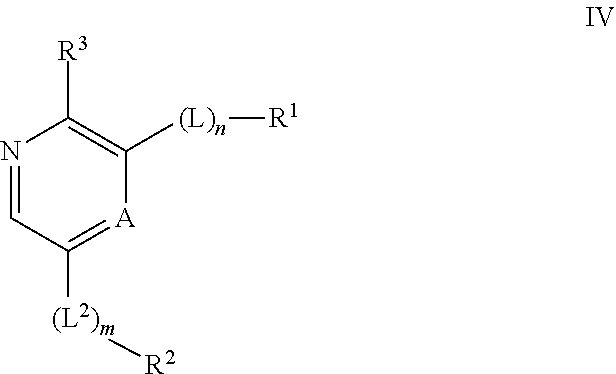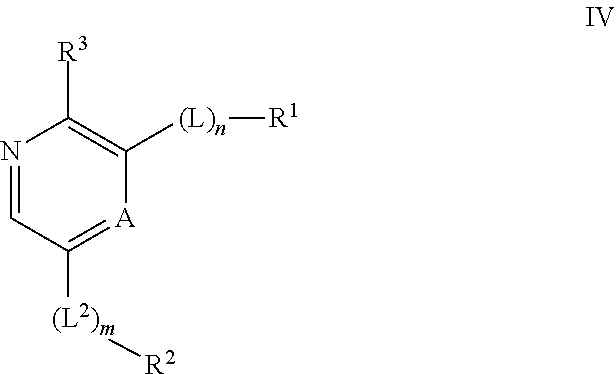Compounds useful as inhibitors of ATR kinase
- Summary
- Abstract
- Description
- Claims
- Application Information
AI Technical Summary
Benefits of technology
Problems solved by technology
Method used
Image
Examples
example 1
3-Methyl-6-(4-(methylsulfonyl)phenyl)-N-phenylpyrazine-2-carboxamide (Compound IV-1)
[0195]
Method A
Step 1: Methyl 3-amino-6-bromopyrazine-2-carboxylate
[0196]
[0197]A mixture of methyl 3-aminopyrazine-2-carboxylate (8.35 g, 54.53 mmol) and N-bromo-succinimide (9.705 g, 54.53 mmol) was stirred in MeCN (100 mL) at RT for 16 hours. The resultant precipitate was filtered, washed with MeCN and dried to give the desired product as a yellow solid (11.68 g, 92% Yield) 1H NMR (400.0 MHz, DMSO) δ 3.85 (s, 3H), 7.55 (br s, 2H) and 8.42 (s, 1H) ppm; MS (ES+) 233.
Step 2: Methyl 3-amino-6-(4-(methylsulfonyl)phenyl)pyrazine-2-carboxylate
[0198]
[0199]A mixture of methyl 3-amino-6-bromo-pyrazine-2-carboxylate (4 g, 17.24 mmol), dichloropalladium; triphenylphosphane (605.0 mg, 0.8620 mmol) and sodium carbonate (25.86 mL of 2 M, 51.72 mmol) in DME (50.00 mL) was heated at 90° C. for 18 hours. The resulting precipitated product was collected by filtration, washed with water and dried to give the required p...
example 2
5-(6-(4-(isopropylsulfonyl)phenyl)pyrazin-2-yl)-3-phenylisoxazole (Compound IV-2)
[0210]
Method B
Step 1: 2-chloro-6-(4-(isopropylsulfonyl)phenyl)pyrazine
[0211]
[0212]A mixture of 2,6-dichloropyrazine (653.1 mg, 4.384 mmol), (4-isopropylsulfonylphenyl)boronic acid (500 mg, 2.192 mmol), Pd(PPh3)4 (126.6 mg, 0.1096 mmol) and Na2CO3 (2.192 mL of 2 M, 4.384 mmol) in ethanol (500.0 μL) and toluene (7.500 mL) was heated at reflux for 72 hours. The reaction mixture was cooled to ambient temperature and diluted with water and DCM. The layers were separated and the aqueous layer was extracted with DCM (×3). The combined organic extracts were dried (MgSO4), filtered and concentrated in vacuo. The residue was purified by column chromatography (ISCO Companion™, 40 g column, eluting with 0 to 40% EtOAc / Petroleum Ether) to give the sub-title product as a white solid (321 mg, 49% Yield). 1H NMR (400.0 MHz, DMSO) δ 9.41 (s, 1H), 8.88 (s, 1H), 8.41 (d, 2H), 8.03 (d, 2H), 3.54-3.49 (m, 1H) and 1.19 (d, 6...
example 3
1-(4-(5-(6-(4-(isopropylsulfonyl)phenyl)pyrazin-2-yl)isoxazol-3-yl)phenyl)-N-methylmethanamine (Compound IV-3)
[0219]
Method C
Step 1: tert-butyl 4-(5-(6-(4-(isopropylsulfonyl)phenyl)pyrazin-2-yl)isoxazol-3-yl)benzyl(methyl)carbamate
[0220]
[0221]NCS (34.97 mg, 0.2619 mmol) was added to a solution of tert-butyl 4-((hydroxyimino)methyl)benzyl(methyl)carbamate (62.93 mg, 0.2381 mmol) in DMF (1 mL) and the mixture heated at 65° C. for 15 minutes. The reaction mixture was cooled to ambient temperature and 2-ethynyl-6-(4-isopropylsulfonylphenyl)pyrazine (75 mg, 0.2619 mmol) and DMF (2 mL) were added followed by the dropwise addition of Et3N (28.91 mg, 39.82 μL, 0.2857 mmol). The mixture was stirred at ambient temperature for 45 minutes then heated to 65° C. for 1 hour. The mixture was cooled to ambient temperature and diluted with EtOAc and water and the layers separated. The aqueous layer was extracted with EtOAc (×2) and the combined organic extracts washed with water (×3), brine, dried (Mg...
PUM
| Property | Measurement | Unit |
|---|---|---|
| Composition | aaaaa | aaaaa |
Abstract
Description
Claims
Application Information
 Login to View More
Login to View More - R&D
- Intellectual Property
- Life Sciences
- Materials
- Tech Scout
- Unparalleled Data Quality
- Higher Quality Content
- 60% Fewer Hallucinations
Browse by: Latest US Patents, China's latest patents, Technical Efficacy Thesaurus, Application Domain, Technology Topic, Popular Technical Reports.
© 2025 PatSnap. All rights reserved.Legal|Privacy policy|Modern Slavery Act Transparency Statement|Sitemap|About US| Contact US: help@patsnap.com



